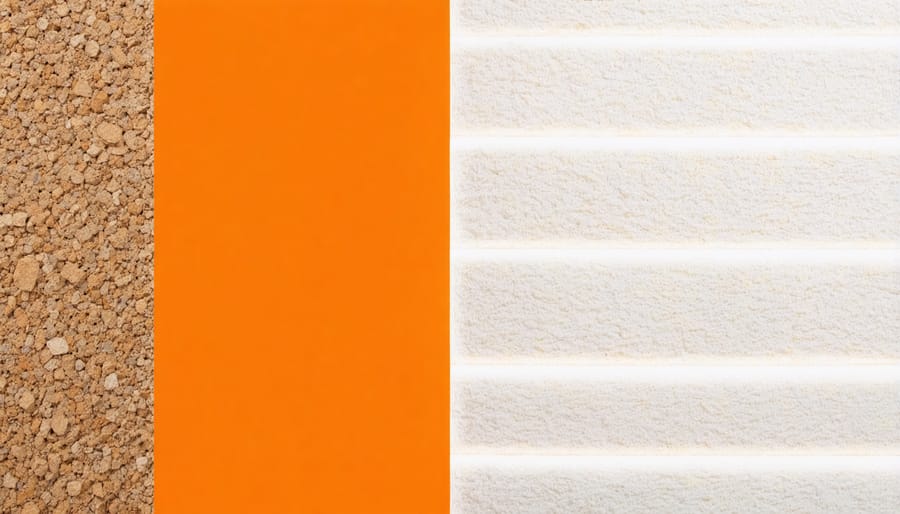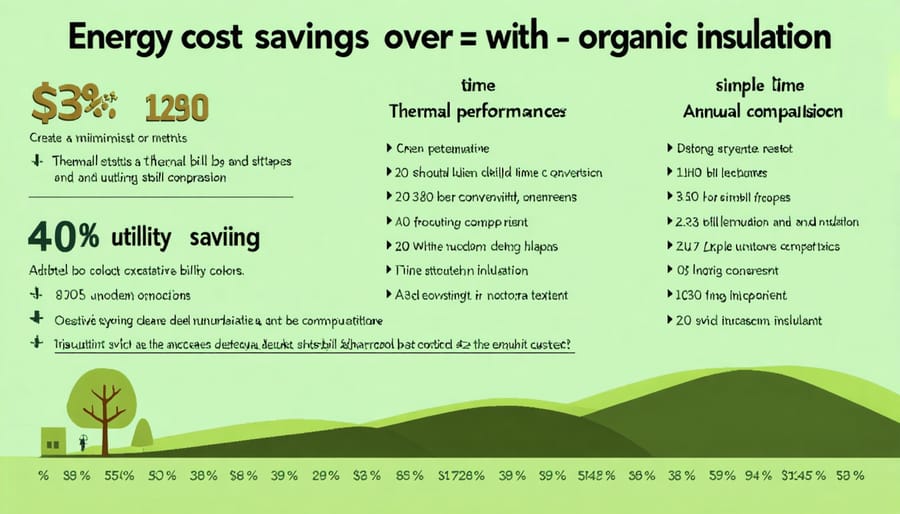
Organic Insulation Makes Your Home Cozier (And Your Bills Lower)
Transform your home’s energy efficiency with organic insulation – nature’s answer to sustainable building comfort. Made from renewable materials like hemp, cotton, wool, and cellulose, organic insulation offers superior thermal performance while reducing your carbon footprint. Unlike synthetic alternatives, these natural materials regulate humidity, prevent mold growth, and create healthier indoor air quality without releasing harmful chemicals into your living space.
Recent studies show organic insulation materials can reduce energy costs by up to 25% while lasting decades longer than conventional options. From recycled denim batts that absorb sound brilliantly to sheep’s wool that naturally filters indoor air pollutants, these eco-friendly solutions are revolutionizing how we think about home comfort. Best of all, many organic options can be installed as DIY projects, making them an accessible choice for environmentally conscious homeowners looking to maximize their property’s energy efficiency while minimizing their environmental impact.
What Makes Insulation ‘Organic’?
Natural vs. Synthetic: The Key Differences
When comparing insulation options, natural insulation materials and synthetic alternatives have distinct characteristics that set them apart. Natural materials like cork, wool, and cotton come from renewable sources and typically require minimal processing, resulting in a lower carbon footprint during manufacturing. These materials are biodegradable and often contain no harmful chemicals, making them safer to handle and healthier for your home environment.
Synthetic insulation, while generally less expensive upfront, is typically manufactured using petrochemicals and energy-intensive processes. Materials like fiberglass and foam-based products can release volatile organic compounds (VOCs) and may require special handling during installation. However, they often provide consistent R-values and are widely available.
Natural options excel in moisture management and temperature regulation, adapting to environmental conditions more effectively than their synthetic counterparts. They also tend to have better sound-dampening properties and can contribute to improved indoor air quality. While the initial investment might be higher, organic materials often last longer and maintain their insulating properties better over time, offering superior long-term value.

Popular Organic Insulation Materials
Cork: The Sustainable Shield
Cork stands out as a remarkable organic insulation material, harvested sustainably from the bark of cork oak trees without harming them. This natural wonder offers excellent thermal and acoustic properties while being naturally fire-resistant and water-resistant. Perfect for walls, floors, and roofs, cork insulation comes in various forms, including boards and granules, making it versatile for different applications. Its cellular structure creates millions of tiny air pockets that trap heat effectively, while its natural antimicrobial properties resist mold and pests. As a bonus, cork insulation can last for decades without degrading, making it a cost-effective choice for long-term home improvement. For environmentally conscious homeowners, it’s worth noting that cork trees continue absorbing more CO2 during the regeneration of their bark, making this truly a sustainable choice for modern homes.
Hemp: Nature’s Insulator
Hemp insulation emerges as a standout choice for eco-conscious homeowners, offering remarkable thermal performance and natural moisture-regulating properties. Made from the stalks of industrial hemp plants, this renewable material creates dense, fiber-based batts that effectively maintain comfortable indoor temperatures year-round. Hemp’s natural resistance to mold, pests, and fire makes it particularly appealing for residential applications, while its ability to sequester carbon during growth adds to its environmental benefits. Installation is straightforward, similar to traditional fiberglass, but without the irritating fibers or harmful chemicals. The material’s breathability helps prevent condensation issues in walls and attics, contributing to better indoor air quality and structural longevity. While the initial cost may be higher than conventional options, hemp insulation’s durability and energy-saving properties often justify the investment.
Sheep’s Wool: Traditional Comfort
Sheep’s wool insulation offers a perfect blend of tradition and modern sustainability. This natural material excels at moisture management, automatically absorbing excess humidity when it’s high and releasing it when conditions are drier. Installation is straightforward, with wool batts fitting snugly between wall studs and ceiling joists, requiring no special protective gear beyond basic gloves. The material’s natural crimp helps it maintain its shape and thickness over time, while its inherent fire resistance adds an extra layer of safety. Wool insulation also acts as a natural air purifier, absorbing and neutralizing harmful chemicals like formaldehyde from your indoor air. While it comes at a premium price point compared to conventional options, many homeowners find the investment worthwhile for its durability, comfort, and environmental benefits.

Cotton and Cellulose: Recycled Solutions
Recycled cotton and cellulose offer an excellent sustainable option for eco-conscious homeowners. Made from post-industrial denim scraps and recycled newspaper, these materials give new life to items that would otherwise end up in landfills. Cotton insulation is naturally fire-resistant and doesn’t require chemical treatments, while cellulose is treated with non-toxic borate compounds for fire and pest resistance. Both materials can be blown into wall cavities or laid as batts, making them suitable for both new construction and retrofitting projects. These insulation types excel at sound dampening and typically achieve R-values between R-3.5 and R-3.7 per inch. Best of all, they’re safe to handle and install, requiring only basic protective gear like gloves and a dust mask.
Installation and Maintenance Tips
Installing organic insulation requires careful planning and attention to detail for optimal performance. Before beginning, ensure your workspace is clean and dry, and gather all necessary safety equipment, including gloves, goggles, and a dust mask.
For loose-fill materials like cellulose or cork granules, start by carefully measuring the space between joists or studs. Use a depth ruler to ensure consistent coverage, and install depth markers to maintain proper thickness throughout. When installing, work from the furthest point toward the access area to avoid compressing already-laid material.
For batt-style organic insulation such as wool or cotton, cut pieces slightly larger than the cavity dimensions for a snug fit. Press the material gently into place, ensuring it fills corners and edges without being compressed, as compression reduces insulation effectiveness.
Maintenance is relatively straightforward but essential. Conduct visual inspections twice yearly, checking for signs of moisture, pest activity, or settling. Pay special attention to areas around pipes, vents, and electrical fixtures. If you notice any dampness, address the source immediately to prevent mold growth.
For long-term care, ensure proper ventilation in your attic or crawl space. Consider installing moisture meters in particularly vulnerable areas to monitor humidity levels. If your insulation gets wet, don’t panic – many organic materials can dry naturally with proper airflow, though severe water damage may require replacement.
Keep detailed records of installation dates and regular inspections. This documentation helps track performance over time and can be valuable for home resale. Remember that organic insulation typically needs replacement every 20-25 years, though this varies based on material type and environmental conditions.
Cost and Energy Savings
While organic insulation materials may have a higher upfront cost compared to conventional options, the long-term financial benefits often make them a smart investment. Initial costs typically range from $1.50 to $4.50 per square foot, depending on the material chosen and installation method. However, these materials can help you boost energy efficiency by up to 25% compared to traditional insulation.
The real savings come from reduced energy bills over time. Homeowners commonly report a 20-30% decrease in heating and cooling costs after installing organic insulation. This means you can typically recoup your initial investment within 3-5 years through lower utility bills.
What makes organic insulation particularly cost-effective is its durability and longevity. Unlike synthetic materials that may need replacement every 15-20 years, organic insulation can last 50+ years when properly installed and maintained. This extended lifespan, combined with its ability to save money and energy, makes it an economically sound choice for long-term property owners.
Additionally, many regions offer tax incentives and rebates for installing eco-friendly insulation materials, which can help offset the initial costs. Check with your local energy office or contractor to learn about available programs in your area.

Environmental Impact
Organic insulation stands out as one of the most environmentally responsible choices in modern construction and renovation. Unlike synthetic alternatives, these materials have a significantly lower carbon footprint during production and often come from renewable resources that can be replenished naturally.
Most organic insulation materials are biodegradable, meaning they won’t sit in landfills for centuries like traditional fiberglass or foam insulation. Materials like hemp, cotton, and sheep’s wool can naturally decompose at the end of their life cycle, returning valuable nutrients to the soil. Additionally, many organic insulation products are made from recycled materials or agricultural byproducts, helping to reduce waste and support sustainable farming practices.
The environmental benefits extend beyond disposal. Organic insulation typically requires less energy to manufacture compared to synthetic materials, resulting in fewer greenhouse gas emissions during production. Many organic options also help regulate indoor air quality by naturally managing moisture and filtering air pollutants, creating healthier living spaces without harmful chemicals or off-gassing.
Perhaps most importantly, organic insulation materials are often sourced locally, reducing transportation emissions and supporting regional economies. Their production generally involves fewer chemical processes and toxic substances, making them safer for both installers and occupants while minimizing environmental impact during manufacturing.
Organic insulation represents a sustainable and effective solution for modern construction and renovation projects. By choosing materials like hemp, cotton, wool, or cork, you’re not just insulating your space – you’re making a conscious decision to reduce your environmental impact while creating a healthier living environment. These natural alternatives offer comparable performance to conventional options while providing additional benefits like moisture regulation and improved air quality. Whether you’re planning a complete home renovation or a small DIY project, organic insulation materials deserve serious consideration. They may require a higher initial investment, but the long-term benefits to both your wallet and the planet make them an increasingly attractive choice for environmentally conscious homeowners. Make the switch to organic insulation and join the growing movement toward sustainable building practices.
